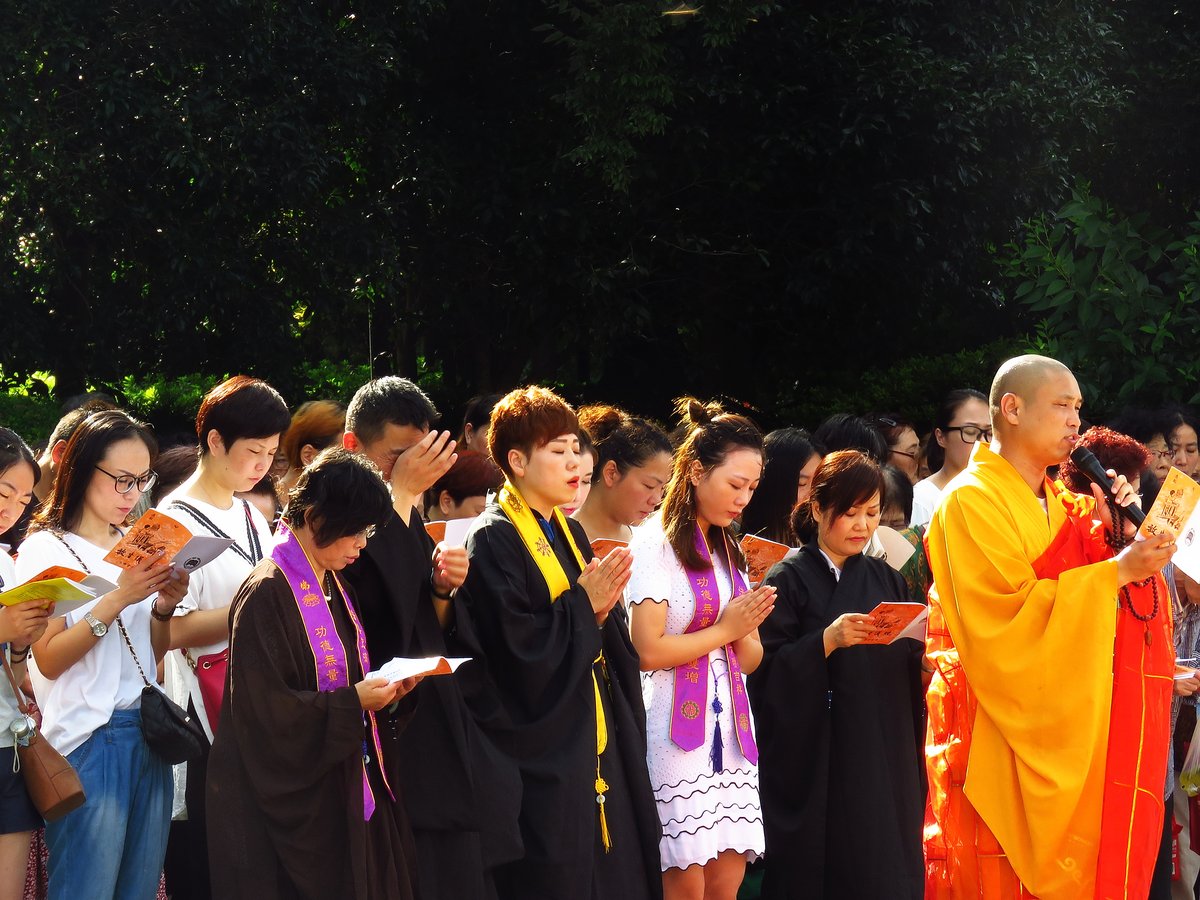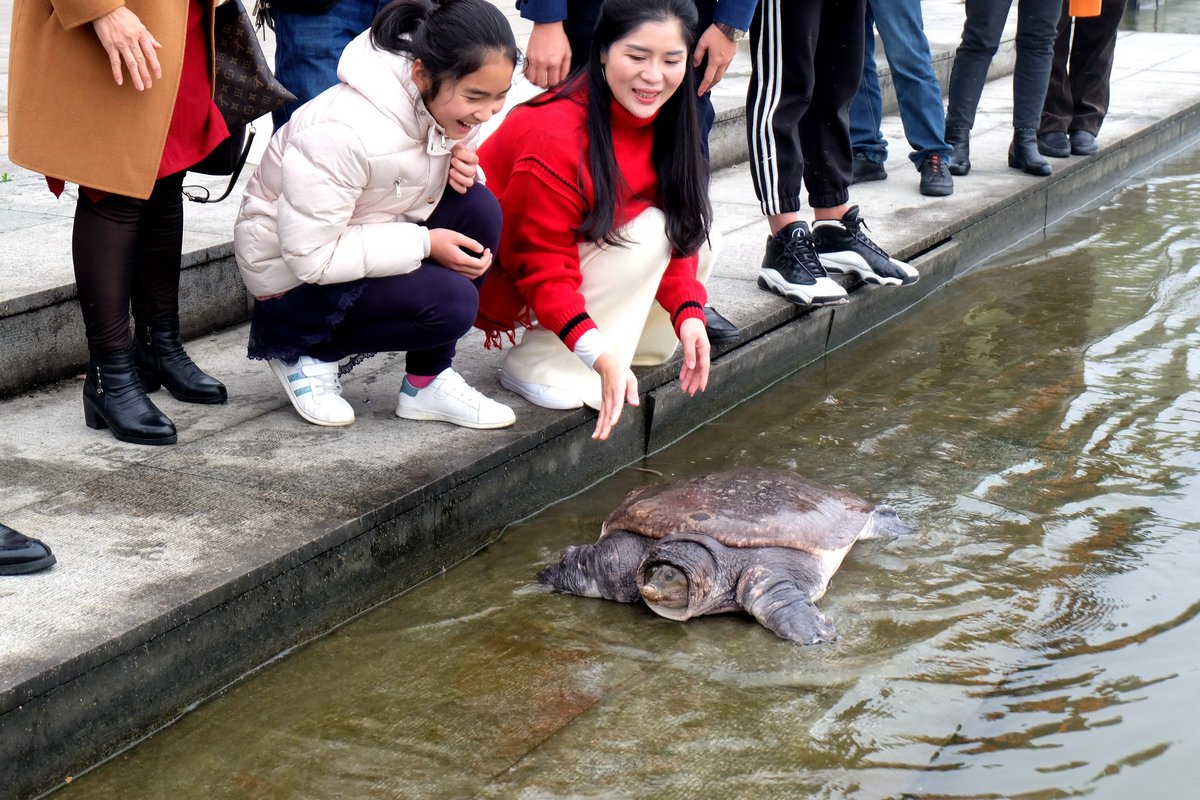How the Buddhist practice of “fangsheng,” the compassionate release of wildlife for merit, gets abused today
On August 26, after three days of effort watched by 37 million cumulative breathless viewers via livestream, officials drained a 200,000 cubic meter lake in Ruzhou, Henan province to find what they were looking for: two specimens of alligator gar, a carnivorous and highly invasive aquatic species endemic to North America, first spotted by passersby in this small city in central China in July.
This wasn’t the only sighting of the so-called “monster fish”: they’ve apparently been reported in a residential compound in Beijing, a park in Qinghai province in the northwest, a tourist site in Guangxi in the southeast, and other sites across China, along with other exotic wildlife such as an endangered Siamese crocodile in Shanghai’s Huangpu River in late September. But this is not the beginning of a doomsday movie: rather, all these animal sightings are believed to originate from a centuries-old compassionate Buddhist practice that has been fraught with abuse in recent years.
Fangsheng (放生), the compassionate releasing of captive animals, supposedly originates from a passage in the Brahmajāla Sūtra saying that one must release animals who are about to be slaughtered. Lay practitioners believe that releasing animals will help them accrue merit, and a 2020 TWOC investigation of the practice showed the many ways that reckless fangsheng could go wrong: freed piranha and venomous snakes have attacked humans, large numbers of fish have died when released into unsuitable waters, and illegal wildlife trafficking networks have sprung up to cater to those willing to pay high prices to release exotic, dangerous creatures for extra merit.
While the latest news puts fangsheng under public scrutiny again, TWOC rounds up some of the most bizarre recent trends in this ritual often associated with the untamable obsession with good karma.
Bottled Karma
Imagine coming across this sight on your leisurely stroll along a river: a group of elderly people, with faces emanating peace and joy, stand next to stack of crates of bottled water; under the guidance of someone dressed like a Buddhist nun, they twist open the bottles one by one and dump the contents into the river.
A viral video of such a group of elders in Guangdong province has been identified as showing the practice of “compassionately releasing water.” A screenshot of a message supposedly from the video-taker states that when they tried to intervene, the elders “said I was interfering with their reverent heart.”
Chinese netizens across social media are scratching their heads for an explanation of this strange ritual. Some believe it’s inspired by the line “the Buddha can see 48,000 worms in a bowl of water” from Everyday Rules for Vinaya Disciples (《毗尼日用切要》), written by Buddhist monk Jianyue (见月) from around the 17th century.
Others suspect that the activity is not fangsheng, bringing up the 2018 sighting of a similar activity in Tianjin, which was accompanied by the chanting of “The Great Compassion Mantra” blasting on a speaker next to a portrait that seems to be of Taiwan’s Master Kuan Ru, who advocates the practice of spilling water blessed with the mantra to bring good karma to lives it touches.
In Guangxi, Guangdong, and Taiwan, similarly devout aunties have been spotted squeezing milk boxes or pouring yogurt into bodies of water. One group even arranged a whole boat for this activity. While wasteful, this activity is perhaps less troublesome than releasing an invasive species that park officials then must drain a whole lake to find.
Karma from the unborn
Sometimes, cost-efficiency matters: why only save one life when you might save thousands more at roughly the same cost? Sustainable fishing practices say one should let go of pregnant female fish, and fangsheng practitioners believe the same. After releasing six carps, a Shanghai fangsheng practitioner once posted about her body count for the day on Weibo, “a total of 486 lives, and about 150,000 fish roe.”
But fish-roe release can get even more bizarre. A few years ago, releasing roe discarded by fishmongers became a trend among enthusiasts. “Scripture has it that roe untouched by salt can survive for three years,” many WeChat posts claim without substantiating, while some even rave “if you release fish roe for 10 days, it can extend your life by 60 years.”
A couple celebrated their wedding by releasing various aquatic species including “52 kilograms of fish roe, costing 297 yuan,” according to a 2018 post on one fangsheng forum on Baidu, a Reddit-like cyber-hub for enthusiasts, which cites the reason as “releasing fish roe brings abundant offspring and happiness.”
The post was inundated by a sea of ecstatic comments, such as “随喜赞叹 (rejoice and praise),” “功德无量 (boundless merit),” and “南无阿弥陀佛 (Namo Amitabha).” Elsewhere on the fangsheng forum, users sometimes refer to fishes and snails as “bodhisattvas,” so a reply that is mechanically littered with Buddhists phrases does not seem out of place.
Fast Returns
You don’t always have to wait until the end of your life to see the benefits of your accrued karma.
Not even two years into this new habit, a user known as “Bingbingbingbing” on the Baidu fangsheng forum showed a screenshot of his bank statement showing a balance of 71,046.94 yuan, and wrote, “Before I began fangsheng, I was waist-deep in debt, hanging by a thread; After I started fangsheng, I accumulated savings, and my life improved.”
Other fangsheng enthusiasts attribute their “good moods,” “catching less colds,” “multiplied income,” and “improved luck” to their habit. TWOC also noted in 2020 that, according to China.com, fangsheng activities peak before the national college entrance exams.
But sober voices also attempt to remind the community of the practice’s roots. “The teaching of Buddhism is about inner compassion and wisdom,” writes user “Lanyuanqingyu” on the forum, “and not just chanting scripture or fangsheng when you have no other options to seek peace and good fortune.”
Outsourced karma
On livestreaming platform Kuaishou, a user called Brother Bo squats by the river with a bucket of small fish before him. With his eyes fixated on the phone screen on a tripod in front of him, he reads one online username for each fish he scoops out and releases into the river. Behind him, a handwritten sign offers “Free Fangsheng.”
Sometimes the small fish livestreamers let go end up reeling in bigger fish. Earlier this month, news site Chengdu.cn estimated that a livestreamer who put a price tag on services of “surrogate fangsheng,” (for example, 158 yuan for a carp and 500 yuan for a Chinese sturgeon) might have raked in at least 140,000 yuan in total revenue.
Li Xia, a 56-year-old woman and a longtime customer of surrogate fangsheng services, tells China Newsweek in addition to paying 500 yuan per month for her regular releaser, she once splashed an auspicious 18,888 yuan for someone to release a Chinese soft-shell turtle because her mother was sick in the hospital.
The term fangsheng is banned on e-commerce platform Taobao, but enthusiasts get around this by searching for daifang (代放, surrogate release). Searching the term on Baidu also produces two results for local fangsheng locations and one result for a Changsha “surrogate release” service, above a Baidu Baike entry explaining the practice. Among the offerings for daifang on Taobao is a picture of buckets of pink goo (supposedly fish roe) ready to be poured into a river while the listing shows that 63 purchases of this service have been made in the past month.
Karma crushed…and chewed!
A livestreaming “battle” with Yu Xiaoqian, in which he gets randomly matched with another livestreamer on the platform to compete to see who gets more interaction from viewers, usually starts out harmless. Yu, who is known for posting videos of himself foraging for seafood on Kuaishou, finds miniature crabs or shrimps under rocks, and asks his opponent, “This one is so cute. How about we fangsheng it?”
As soon as the unsuspecting opponent nods, we hear Yu, off screen, putting the crustacean in his mouth and chewing, and the next time we see the little creature, half of its body is missing, while the remaining half is defined by a line of teeth marks.
Among seafood-foraging vloggers (yes, a real subcategory in the Chinese livestreaming world), the word fangsheng has taken on a twisted meaning as an abbreviation for 放进嘴里生吃 (fàngjìn zuǐli shēngchī, putting in the mouth and eating raw), or alternatively 放弃生命 (fàngqì shēngmìng, giving up life). First-time watchers may wince with discomfort, but given that Yu has 5 million followers, there seems to be no shortage of people enjoying these gruesome scenes.
The lazy do-gooders seeking “karma by proxy” on online streaming platforms may want to exercise caution: instead of watching joyful scenes of animals reunited with nature, they could instead fangsheng themselves in despair over humanity.















